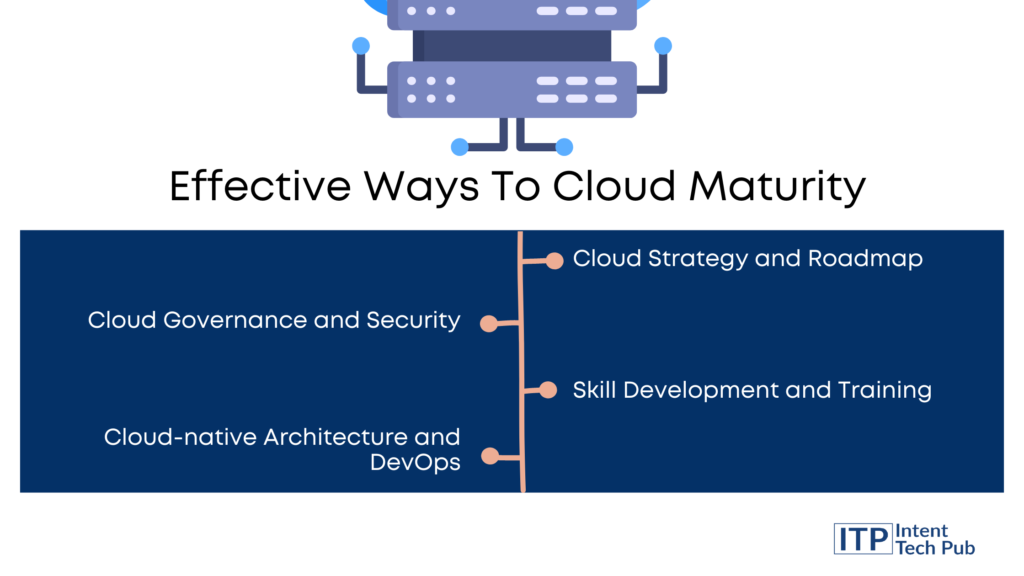or call: +1 (845) 347-8894

or call: +1 (845) 347-8894
or call: +1 (845) 347-8894

“Cloud is about how you do computing,
-Paul Maritz
Not where you do computing.”
Cloud computing has become a game-changer in today’s digital era, providing organizations with the ability to improve scalability, optimize operations, and foster innovation. Cloud technology has become increasingly popular among businesses due to its numerous benefits.
As a result, the focus has shifted from simply adopting cloud technology to achieving cloud maturity. A crucial factor that can determine the success of your cloud adoption journey is your comprehension of cloud maturity. The following blog talks about cloud maturity, its importance, and how it can facilitate a seamless cloud transformation.
Cloud maturity can be defined as the extent to which an organization is able to effectively utilize cloud computing services, optimizing and integrating them into their operations to achieve a high level of proficiency. Successful cloud adoption requires more than just the initial stages. It involves a thorough grasp of cloud technologies, implementation of best practices, and the capability to fully utilize the potential of the cloud ecosystem.
Achieving cloud maturity is a gradual process that requires the refinement of organizational processes, culture, and skill sets to align with a cloud-first approach and fully utilize the potential of the cloud ecosystem.
Achieving cloud maturity is crucial for organizations to fully utilize the diverse range of cloud capabilities and optimize their return on investment (ROI). By enabling efficient resource utilization, cost optimization, and enhanced operational efficiency, this approach delivers substantial cost savings and improved business outcomes.
The level of cloud maturity that a business possesses can greatly enhance its ability to adapt to market demands with agility and scalability. This, in turn, can empower the business to respond quickly and effectively to changing circumstances. By leveraging cutting-edge cloud services and architectures, businesses can easily adjust their infrastructure to meet changing demands, optimize application performance, and maintain uninterrupted operations, even during periods of high traffic.
The development of cloud maturity is crucial for fostering a culture of innovation within organizations. This allows for the creation of a solid foundation that enables experimentation, iteration, and the rapid deployment of new services and products. Businesses can gain a competitive edge in the market and drive customer satisfaction by utilizing advanced cloud technologies such as AI, machine learning, and big data analytics. These cutting-edge tools enable companies to stay ahead of the curve and provide superior services to their customers.

Crafting a thorough plan and direction for cloud adoption is the initial phase in achieving a higher level of cloud proficiency. To successfully migrate to the cloud, it is essential to conduct a thorough evaluation of the business requirements and clearly define the goals.
The next step is to identify the appropriate cloud service models, such as Infrastructure as a Service (IaaS), Platform as a Service (PaaS), and Software as a Service (SaaS). Finally, a well-planned and phased approach for migration and transformation should be formulated to ensure a smooth transition to the cloud.
To attain cloud maturity, it is essential to implement strong cloud governance frameworks and security measures. In order to maintain compliance, data protection, and risk management within a cloud environment, it is essential to establish clear policies, procedures, and controls. These measures serve to safeguard against potential threats and ensure the secure handling of sensitive information.
In order to achieve cloud maturity, it is imperative to establish a proficient workforce that possesses the necessary skills in cloud technologies. Investing in training programs and certifications is crucial for organizations seeking to enhance their employees’ skills and enable them to effectively utilize cloud services.
By incorporating cloud-native architectures and implementing DevOps methodologies, organizations can expedite their cloud maturity. To improve flexibility, scalability, and speed to market, companies are adopting various modern technologies and methodologies such as containerization, microservices, serverless computing, and agile development.
Evaluating cloud maturity involves analyzing an entity’s proficiency and progress in implementing and executing cloud-based solutions. Various methodologies and frameworks exist to assess this level. Here are several commonly used techniques:
Cloud maturity models offer a systematic approach to assess an organization’s cloud proficiency. They consist of stages that businesses can advance through, improving their cloud maturity by evaluating cloud usage and identifying areas for development. Examples include:
Cloud maturity evaluations can be performed by organizations through the use of maturity assessments or surveys. Cloud technology assessments usually consist of a series of questions or criteria that evaluate an organization’s proficiency, methodologies, and comprehension of cloud technologies. The results of the assessment offer valuable insights into both the strong points and the areas that require improvement.
To measure the level of cloud maturity, it is essential to define and track specific Key Performance Indicators (KPIs) related to cloud adoption and utilization. Key Performance Indicators (KPIs) are essential metrics that organizations use to measure the success of their cloud computing strategy. These KPIs may include factors such as optimizing cloud spend, reducing the time it takes to deploy new applications in the cloud, ensuring high system uptime, achieving scalability, and realizing efficiency gains through cloud technologies.
To obtain an impartial assessment of an organization’s cloud maturity, involve external experts or conduct internal audits. Professionals with expertise can evaluate cloud architecture, security controls, governance practices, and alignment with industry best practices. The valuable insights provided by individuals can aid in the identification of gaps and the recommendation of improvements.
Examining case studies of successful organizations that have attained advanced levels of cloud maturity can offer valuable insights and benchmarks. By examining the latest industry trends, best practices, and accomplishments of peer organizations, it is possible to assess the maturity level of an organization and pinpoint opportunities for growth and development.
It is crucial to emphasize that evaluating cloud maturity is not a one-time event, but rather a continuous and recurrent undertaking. It is imperative for organizations to periodically evaluate their maturity levels as they advance in their cloud adoption expedition. This will enable them to enhance their approaches, methodologies, and competencies, thereby attaining superior levels of cloud maturity.
Achieving cloud maturity is crucial for successful cloud adoption. This process goes beyond initial computation stages, focusing on transforming organizational processes, skills, and culture. Embracing cloud maturity unlocks your business’s full potential, maximizes ROI, drives innovation, and provides a competitive edge.
In today’s dynamic business landscape, reaping the rewards of cloud computing is not a one-time process but rather an ongoing journey that demands meticulous planning, strategic execution, and constant improvement.
